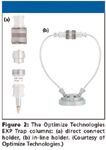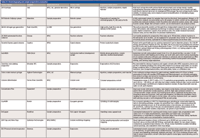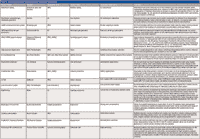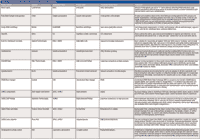New Chromatography Columns and Accessories at Pittcon 2010: Part II
LCGC North America
Ron Majors presents the second part of his yearly review of all that was new and innovative at Pittcon 2010, held this year in Orlando, Florida.
Pittcon 2010, referred to in its full name as the 61st Pittsburgh Conference on Analytical Chemistry and Applied Spectroscopy, returned to the massive Orange County Convention Center in Orlando, Florida, from February 28 to March 5, 2010. This year's event hosted 960 instrument manufacturers and 1aboratory suppliers in more than 2000 booths. In addition to attending the exposition, the conferees listened to 2000 technical presentations, checked numerous company seminar rooms, or attended one of 140 short courses.

Ronald E. Majors
Undoubtedly, Pittcon still remains the most important yearly international analytical exhibition, where companies introduce their latest instruments, instrument accessories, software, columns, sample preparation, and other consumable products. Because many past attendees have purchased one or more new products within three months after attending the show, most exhibitors attempt to maximize their booth traffic to meet as many potential customers as possible.
The purpose of this report is to provide information about many of the new separation consumables and accessory products that will be displayed at Pittcon 2010. In some cases, products that were introduced during 2009 but after Pittcon 2009 (1,2) may be included for reasons of completeness. The information is based upon manufacturers' responses to a questionnaire mailed in early 2010. Because of space limitations and the fact that some manufacturers did not respond to the questionnaire, this report cannot be considered an exhaustive listing of all new products that were introduced in Orlando.
However, over the years, these Pittcon introduction summaries have provided a good source of information that would be difficult for one individual to gather during the four days of the exhibition. In addition, the products introduced have shown definite correlations to current research, development, and application activity in the separation sciences.
As in previous years, columns and other products recommended by their manufacturers primarily for biomolecule separations or sample preparation are denoted in the tables with the designation BIO. Some of these products might be used for general high performance liquid chromatography (HPLC) separations as well, but their main emphasis is for biological samples.
In last month's coverage, I described new introductions in the areas of HPLC and reversed-phase, normal- and bonded-phase, ion-exchange and ion, size-exclusion, large- and preparative-scale, and specialty chromatography columns. This month, I will look at gas chromatography (GC) columns, sample preparation products, and hardware, accessories, and small tabletop instruments, mainly for sample preparation.
Gas Chromatography
Although GC is considered to be a relatively mature separation technique, new GC columns continue to be introduced each year at Pittcon (Table I). This year introductions were rather sparse compared to previous years: a new family of columns, six new individual columns, and a guard column were introduced. The GC columns were all wall-coated open tubular (WCOT) format.

Table I: Gas chromatography columns
In line with recent introductions, Thermo Fisher Scientific (Madison, Wisconsin) introduced a new family of GOLD GC columns that are their low bleed, inert capillary products. The brand name GOLD also has been used for their improved line of ultrahigh-pressure liquid chromatography (UHPLC)/HPLC columns.
Applications-specific GC columns are always popular introductions at Pittcon. This year, a majority of the columns were for specific application areas. In the environmental domain, columns for the U.S. Environmental Protection Agency's polynuclear aromatic hydrocarbons (PAH) were introduced by Varian (Palo Alto, California) and Agilent (Santa Clara, California). The Varian column has a proprietary PAH selector that was designed to optimally separate the difficult pairs, including the chrysene and triphenylene peaks. The Agilent column was designed to meet the EU PAH method so each column is tested to ensure separation of the compounds in their mixture. Other applications-specific GC capillary columns introduced at Pittcon included those for detailed hydrocarbon analysis and U.S. EPA priority pollutants.
Gas chromatographers are always asking for their columns to do more so Phenomenex (Torrance, California) has launched additional phases in their high-temperature Inferno line of GC capillary columns. Normally, when columns are pushed to 400 °C, metal columns are used. Phenomenex stays with a polymeric coating for the fused-silica capillary housing that allows them to be used at that temperature. The higher temperature capability allows the columns to analyze even higher boilers or permits the column to be baked to remove high boiling contaminants that could bleed and cause problems.
Sample Preparation Products
As indicated in Table II, Pittcon 2010 was another productive year with 21 new sample preparation products or families of products displayed. Not counted were sample preparation accessories (Table III), which will be covered later. Among the more popular introductions were products to deal with increasingly smaller amounts of available sample. Many solid-phase extraction (SPE) products ranging from small mass cartridges to pipette-tips to 96-well plates were among the formats introduced. Just about every mode of SPE (reversed phase, strong anion, and cation exchange, adsorption–normal phase, complexation, mixed mode and hydrophilic interaction liquid chromatography [HILIC]) was representative. A wide variety of media were introduced at Pittcon including polymer-based, carbon and graphitized carbon black, silica-based, and a number of other inorganic oxides (for example, ZrO2, Al2O2, Florisil).

Table II: Sample preparation products
About half of the SPE products introduced at Pittcon 2010 were polymer-based. Polymeric SPE products are particularly attractive because they can dry out during the conditioning steps without affecting the recovery and reproducibility of the SPE experiment. They also can be treated with more aggressive washing solvents than silica-based sorbents because their pH range is greater. Another advantage of the polymeric SPE sorbents is that they often display mixed mechanisms and multiple interactions, which can be used to retain analytes or matrix compounds selectively. Because the surface area of polymers is higher than silica-based bonded phases, a smaller amount is used in cartridges, disks, and well plates. Thus, smaller amounts of sample and solvents as well as faster extraction times and faster evaporation times with reconstitution are required.

Table II: Sample preparation products (continued)
Products for QuEChERS were first introduced two years ago (2). Pronounced "catchers," QuEChERS is an acronym for quick, easy, cheap, effective, rugged, and safe sample preparation. This method is an emerging technique becoming increasingly popular in the area of multiresidue pesticide analysis in food and agricultural products. In QuEChERS, food and agricultural samples are extracted with first an aqueous miscible solvent (for example, acetonitrile) in the presence of high amounts of salts (for example, sodium chloride and magnesium sulfate) and buffering agents (for example, citrate) to induce liquid-phase separation and stabilize acid- and base-labile pesticides, respectively. Upon shaking and centrifugation, an aliquot of the organic phase is subjected to further clean up using SPE. Unlike traditional methods using SPE tubes, dispersive SPE cleanup is conducted by mixing bulk amounts of SPE sorbent and additional MgSO4 with the extract. After sample clean up, the mixture is centrifuged, and the resulting supernatant can either be analyzed directly or can be subjected to (minor) further treatment before analysis. Three new QuEChERS product offerings were submitted for inclusion into my Pittcon 2010 article. (see Table II). For those interested, a brief introduction to the technique was published in an earlier "Sample Preparation Perspectives (3). One aspect of this "just enough" sample preparation technique is that it is now extending beyond the analysis of pesticides in fruits and vegetables and has been used for additional classes of analytes in a diverse number of matrices (for example, antibiotics in meat and PAHs in soil).
In addition to QuEChERS, which is used primarily in food-safety analysis, other applications-specific SPE phases were introduced this year. In the environmental area, the SPE technique is now well accepted by regulatory agencies as a substitute for older methodologies like liquid–liquid extraction. New SPE products for EPA method 8270 for semivolatile organics in drinking and surface water were introduced at Pittcon. Other application-specific phases for oligonucleotides, trace organics in aqueous samples, acids and bases, drugs of abuse, proteins, drugs in plasma, and phospholipids in plasma were to be seen on the exhibition floor.

Companies Listed in This Column
One very interesting sample prep column was Varian's StratoSpheres PL-HCO3 MP. The large-volume cartridge is used to remove trifluoroacetic acid from HPLC effluents. Often, when proteins or peptides are purified by HPLC, they are isolated as their trifluoroacetic acid salt; the trifluoroacetic acid must be removed before further processing. This often is accomplished by repetitive freeze-drying, which is time consuming and costly. This quaternized polymer-based strong anion exchanger with a bicarbonate counterion can remove 1% trifluoroacetic acid from 500 mL of solution by merely passing the liquid through the cartridge.
Membranes are often very useful as sample preparation media. By selecting the appropriate molecular weight cut-off membrane, proteins can be excluded or alternatively, salts can be removed from protein mixtures. Figure 1 shows the desalting and concentration capabilities of a membrane-based filter. The Amicon Ultra-0.5 mL filter (Millipore, Billerica, Massachusetts) can remove salts or exchange buffers by concentrating the sample, then reconstituting the concentrate to the original sample volume with any desired solvent. The process of "washing out" can be repeated until the concentration of the contaminating microsolute has been reduced sufficiently.

Figure 1
Chromatography and Sample Preparation Accessories
Table III lists 41 new hardware products and accessories for HPLC, GC, CE, and sample preparation. This year, I have extended the columns and sample preparation accessories to include small, benchtop-dedicated instruments that are designated to automate some of the sample preparation techniques reported in Table II. All of the products introduced were practical devices designed to make the chromatographer's life easier. I will cover each area individually.
General Chromatography Products: Everybody uses vials for automation; instruments are getting more sensitive. So this year, a new breed of ultra clean, GC–mass spectrometry (MS) and LC–MS-tested certified vials were introduced. In addition, a fused vial–insert combination designed to eliminate movement and potential needle damage was shown. The manual capping and decapping of vials takes a lot of time and can cause fatigue. To automatically cap and decap vials, a decapper system was introduced this year. New precut septa were shown. The slit in the laminated septum allows easy needle penetration yet prevents evaporation of volatiles from the vial. Finally, color-coded manual syringes help those mix-ups that can occur when quickly picking up a syringe to perform injections or liquid transfer.
HPLC, LC–MS, and Ion Chromatography Products: With the current interest in UHPLC, peripherals capable of handling high pressures have begun to emerge. The UHPLC instruments now have pressure capabilities up to 1300 bar so system components need to stand up to these pressures. In addition, because UHPLC columns are very sensitive to particulate contamination, in-line filters designed to prevent plugging are becoming commonplace. This year, high-pressure fittings, in-line filters, on-line traps, and an injector were introduced. An example of one of the UHPLC peripherals is shown in Figure 2. The Optimize Technology (Oregon City, Oregon) EXP trap columns for sample cleanup can be used in a direct connect configuration via a holder (Figure 2a) or can be inserted into a six- or ten-port valve for column switching applications (Figure 2b).

Figure 2
In the same vein, guard columns also offer an additional level of protection not only for UHPLC columns but conventional columns as well. Four companies introduced guard columns to meet this need.
Other notable LC accessories introduced included a chiller/heater, fraction collector, a method development add-on instrument, a rack to hold LC modules, and an in-line bubble trap.
GC Products: With the world's supply of helium dwindling and becoming more expensive, users are looking for other carrier gas sources that can provide an inexpensive, safe, pure, and plentiful gas supply. Hydrogen gas has superior properties to helium in terms of diffusivity and viscosity but users often are concerned about having additional cylinders of hydrogen around the laboratory. Hydrogen generators can provide carrier gas without fear of safety because only a few tens of milliliters are actually present at any given time. A new hydrogen generator was introduced this year. For performing quantitative analysis of volatiles, preparing standards is always a hassle. A new instrument designed to generate calibration standards automatically is a welcome addition to the GC laboratory. An improved instrument that performs end-to-end GC capillary column connections with no dead volume and that is capable of high-temperature operation without leaking was shown at Pittcon.

Table III: Chromatography and sample preparation accessories
Sample Preparation Products: Devices such as evaporators, concentrators, homogenizers, cryomills, and heater blocks are designed to take away some of the drudgery of sample preparation. In addition, small robotic devices automated part of the sample preparation workflow such as extraction and evaporation. All of these sample preparation products are always found on the Pittcon floor. Table III lists some of those products shown this year, many with improved features over previous models.

Table III: Chromatography and sample preparation accessories (continued)
Solid-phase microextraction (SPME) is a favored sample preparation technique mainly for GC. SPME fibers have a finite lifetime and must be changed periodically. For its MPS sampling system, Gerstel has developed an accessory in which the SPME fibers can be changed automatically at time intervals specified by the user. This feature improves overall laboratory throughput and productivity.

Table III: Chromatography and sample preparation accessories (continued)
Acknowledgment
I would like to thank the manufacturers and distributors who kindly furnished the requested information in advance of Pittcon 2010, thus allowing a timely report on new product introductions. Manufacturers who would like to be considered for inclusion into Pittcon 2011 coverage: please send primary company contact, mailing address, FAX and e-mail address to David Walsh, Editor, LCGC North America, c/o Advanstar Communications, 485 Rte. 1 South, Bldg. F, Iselin, NJ 08830, Attn.: Pittcon 2011 "Column Watch."
Ronald E. Majors "Column Watch" Editor Ronald E. Majors is Senior Scientist, Columns and Supplies Division, Agilent Technologies, Wilmington, Delaware, and is a member of LCGC's editorial advisory board. Direct correspondence about this column to "Column Watch," LCGC, Woodbridge Corporate Plaza, 485 Route 1 South, Building F, First Floor, Iselin, NJ 08830, e-mail lcgcedit@lcgcmag.com.
References
(1) R.E. Majors, LCGC 28(3), 192–210 (2010).
(2) R.E. Majors, LCGC 26(4), 334–350 (2008).
(3) R.E. Majors, LCGC 25(5), 436–446 (2007).

New Study Reviews Chromatography Methods for Flavonoid Analysis
April 21st 2025Flavonoids are widely used metabolites that carry out various functions in different industries, such as food and cosmetics. Detecting, separating, and quantifying them in fruit species can be a complicated process.
University of Rouen-Normandy Scientists Explore Eco-Friendly Sampling Approach for GC-HRMS
April 17th 2025Root exudates—substances secreted by living plant roots—are challenging to sample, as they are typically extracted using artificial devices and can vary widely in both quantity and composition across plant species.

.png&w=3840&q=75)

.png&w=3840&q=75)



.png&w=3840&q=75)



.png&w=3840&q=75)









